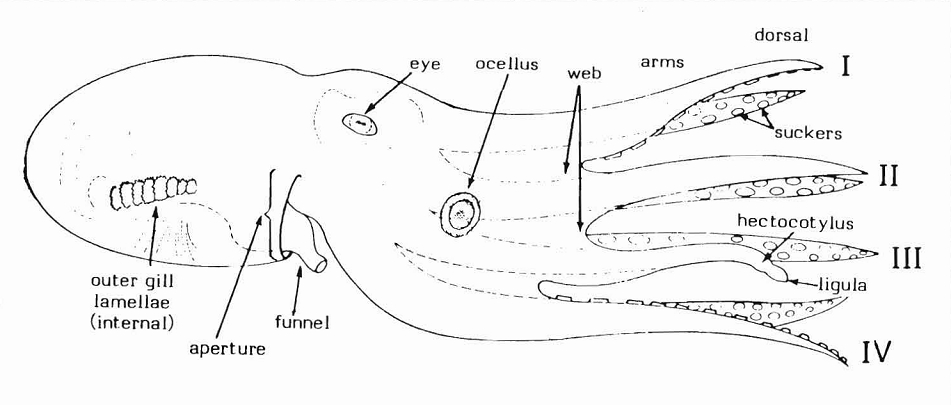|
Patelloctopodidae
Patelloctopodidae is a family of stem-octopod cephalopods from the Middle and Late Jurassic of Europe. Five genera are currently placed in the family, '' Etchesia, Muenstellerina,'' '' Patelloctopus,'' '' Pearciteuthis'' and '' Tyrionella,'' Patelloctopodidae is one of two families in the superfamily Muensterelloidea along with the Muensterellidae Muensterellidae is a family of stem-octopod cephalopods from the Late Jurassic to Late Cretaceous. Phylogeny Muensterellidae is one of two families in the superfamily Muensterelloidea along with the Patelloctopodidae. The muensterelloids are c .... References Octopuses Prehistoric cephalopod fam ...[...More Info...] [...Related Items...] OR: [Wikipedia] [Google] [Baidu] |
Muensterelloidea
Muensterelloidea is a superfamily (or clade) of stem-octopod cephalopods from the Early Jurassic to Late Cretaceous. Two families are currently identified, Muensterellidae, and Patelloctopodidae. The clade is the ancestral group from which modern octopus arose. Description Overall Soft tissue anatomy within the Muensterelloidea is well-documented. Muenster (1842), who first recorded the holotype specimen of ''Muensterella'', noted its egg-shaped anatomy and apparent lack of swimming fins.Fuchs, D., Keupp, H., & Engeser, T. (2003). New records of soft parts of Muensterella scutellaris Muenster, 1842 (Coleoidea) from the Late Jurassic Plattenkalks of Eichstätt and their significance for octobrachian relationships. Berliner Paläobiologische Abhandlungen, 3, 101-111. Indeed, in all preserved specimens the same body structure is present, with all lacking a distinct swimming fin. Fuchs ''et al.'' (2003) suggested it possessed marginal fins, as a s ... [...More Info...] [...Related Items...] OR: [Wikipedia] [Google] [Baidu] |
Muensterellidae
Muensterellidae is a family of stem-octopod cephalopods from the Late Jurassic to Late Cretaceous. Phylogeny Muensterellidae is one of two families in the superfamily Muensterelloidea along with the Patelloctopodidae. The muensterelloids are characterized by having a roughly spoon-shaped end of the gladius ''Gladius'' () is a Latin word meaning "sword" (of any type), but in its narrow sense it refers to the sword of ancient Roman foot soldiers. Early ancient Roman swords were similar to those of the Greeks, called '' xiphe'' (plural; singular ''xi ... called the patella. This type of gladius is likely ancestral to the gladius remnants of modern octopuses. References {{Taxonbar, from=Q30434538 Octopuses Prehistoric cephalopod families ... [...More Info...] [...Related Items...] OR: [Wikipedia] [Google] [Baidu] |
Etchesia
''Etchesia'' is a genus of muensterellid stem-octopod from the Kimmeridge Clay Formation of southern England. It is monotypic, consisting solely of type species In zoological nomenclature, a type species (''species typica'') is the species name with which the name of a genus or subgenus is considered to be permanently taxonomically associated, i.e., the species that contains the biological type specimen ... ''E. martilli''. References {{Taxonbar, from=Q107304041 Octopuses Prehistoric cephalopod genera ...[...More Info...] [...Related Items...] OR: [Wikipedia] [Google] [Baidu] |
Octopus
An octopus ( : octopuses or octopodes, see below for variants) is a soft-bodied, eight- limbed mollusc of the order Octopoda (, ). The order consists of some 300 species and is grouped within the class Cephalopoda with squids, cuttlefish, and nautiloids. Like other cephalopods, an octopus is bilaterally symmetric with two eyes and a beaked mouth at the center point of the eight limbs. The soft body can radically alter its shape, enabling octopuses to squeeze through small gaps. They trail their eight appendages behind them as they swim. The siphon is used both for respiration and for locomotion, by expelling a jet of water. Octopuses have a complex nervous system and excellent sight, and are among the most intelligent and behaviourally diverse of all invertebrates. Octopuses inhabit various regions of the ocean, including coral reefs, pelagic waters, and the seabed; some live in the intertidal zone and others at abyssal depths. Most species grow quickly, mature ea ... [...More Info...] [...Related Items...] OR: [Wikipedia] [Google] [Baidu] |
Octopuses
An octopus ( : octopuses or octopodes, see below for variants) is a soft-bodied, eight- limbed mollusc of the order Octopoda (, ). The order consists of some 300 species and is grouped within the class Cephalopoda with squids, cuttlefish, and nautiloids. Like other cephalopods, an octopus is bilaterally symmetric with two eyes and a beaked mouth at the center point of the eight limbs. The soft body can radically alter its shape, enabling octopuses to squeeze through small gaps. They trail their eight appendages behind them as they swim. The siphon is used both for respiration and for locomotion, by expelling a jet of water. Octopuses have a complex nervous system and excellent sight, and are among the most intelligent and behaviourally diverse of all invertebrates. Octopuses inhabit various regions of the ocean, including coral reefs, pelagic waters, and the seabed; some live in the intertidal zone and others at abyssal depths. Most species grow quickly, mature early, a ... [...More Info...] [...Related Items...] OR: [Wikipedia] [Google] [Baidu] |
